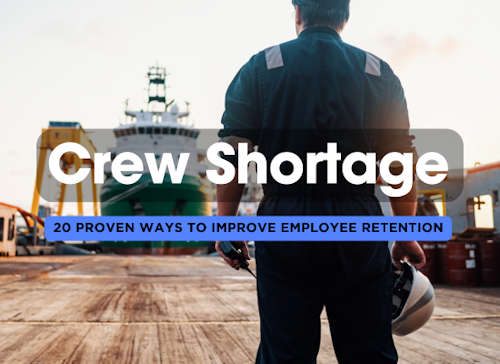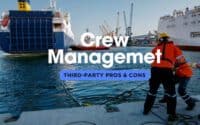Crew Shortages: 20 Proven Ways to Improve Employee Retention

The maritime sector is grappling with significant crew shortages, particularly for skilled officers and engineers. Addressing this challenge requires a multifaceted approach that balances recruitment, retention, and operational innovation. Here are twenty detailed strategies with actionable insights to help shipowners effectively manage crew shortages.

1. Enhance Recruitment and Training Programs 🎓
One of the first steps to addressing crew shortages is building robust recruitment pipelines and improving training processes. Shipowners can partner with maritime academies to offer targeted scholarships and internship programs, providing real-world experience at sea. Additionally, companies can fast-track certification processes, especially for positions like engineers and officers, by introducing intensive training courses that condense learning timelines while ensuring qualifications are met. This can include offering accelerated pathways for military veterans and other professionals transitioning into maritime careers.
Scholarship & Sponsorship Initiatives
Provide financial assistance or full scholarships for students in maritime academies. Offering this support can attract younger talent who may have otherwise pursued different career paths, helping to secure a future supply of skilled crew members.
Fast-Track Training for Essential Roles
Develop specialized, condensed courses focusing on critical roles such as deck officers or marine engineers. These programs ensure that recruits become qualified quickly while maintaining high standards of competency, reducing onboarding time.
Veteran Transition Programs
Create transition programs for veterans, offering streamlined credentialing for those with relevant experience. Veterans bring discipline and valuable skills, making them ideal candidates for maritime roles.
2. Increase Wages and Benefits 💰
To attract and retain skilled crew members, companies must offer competitive wages and comprehensive benefits. Maritime work is demanding, and incentives such as higher salaries, paid leave, robust insurance packages, and retirement plans can help keep crew members onboard for longer periods. Providing bonuses for extended contracts or loyalty rewards for repeat service can further enhance retention.
Competitive Salary Adjustments
Review industry salary benchmarks and ensure wages are competitive, especially for high-demand roles like chief engineers or senior officers. Offering above-average pay can make your company more attractive to skilled seafarers.
Expanded Benefits Packages
Provide comprehensive health insurance, disability coverage, and life insurance as part of the benefits package. Crew members value financial security, and these benefits can be a major incentive to stay.
Loyalty and Retention Bonuses
Introduce loyalty programs where seafarers receive bonuses for completing multiple contracts or staying with the company for several years. This reduces turnover and builds long-term crew relationships.
3. Promote Work-Life Balance and Mental Health Support 🌊
The long periods away from home can take a toll on seafarers' mental health and work-life balance, leading to burnout and high turnover. Shipowners can mitigate this by offering support systems, including mental health services, access to telemedicine, and flexible leave options. Creating a healthier onboard environment, with recreational activities and downtime, can also help crew members maintain their well-being.
Onboard Mental Health Services
Offer access to telemedicine platforms where crew members can consult with mental health professionals while at sea. Ensuring that seafarers have mental health support is critical for maintaining a productive workforce.
Flexible Contract Durations
Allow crew members to choose contract lengths that suit their personal and family needs. Flexibility in contract durations can reduce the stress associated with long deployments, improving job satisfaction.
Recreational Facilities & Activities
Provide facilities such as gyms, internet access, and recreation rooms onboard. Offering activities and spaces for relaxation can help improve morale during long voyages.
4. Foster a Positive and Inclusive Onboard Culture 🏅
Building a positive working environment can help increase retention by ensuring that crew members feel valued and respected. This includes fostering a multicultural and inclusive atmosphere where all seafarers, regardless of nationality or background, feel comfortable and appreciated. Strong leadership and mentorship programs onboard can also support a more harmonious crew dynamic.
Cultural Awareness Training
Implement training programs that educate crew members on working in multicultural environments, ensuring that communication and teamwork are effective. This can reduce conflicts and create a more cohesive work environment.
Mentorship Programs
Establish mentorship systems where senior officers guide and support junior crew members. Having a mentor onboard improves career development and helps crew members feel more supported in their roles.
Recognition and Reward Systems
Regularly recognize crew members for outstanding performance or contributions. Simple gestures like acknowledging achievements or celebrating birthdays can greatly enhance crew morale and loyalty.
5. Invest in Crew Retention Through Continuous Training and Career Development 📚
Providing ongoing training and clear career development paths for crew members can enhance retention. Crew members are more likely to stay with companies that invest in their long-term growth. Offering opportunities for skill development, certifications, and leadership training helps crew members advance and increases job satisfaction. Additionally, this investment in professional growth positions them for higher-ranking roles, reducing the need for external hires.
Career Advancement Programs
Create programs where crew members can train for higher-ranking positions, such as moving from second officer to chief officer. Clear promotion pathways provide motivation and stability, encouraging crew members to stay longer.
Certification Assistance
Offer financial or logistical support for crew members looking to acquire advanced certifications, such as Master’s licenses or technical specialties. Helping crew members grow professionally ensures your fleet has the skills needed for future operations.
6. Improve Onboard Living Conditions 🛏️
Enhancing the living environment on ships is a critical way to attract and retain crew members. Seafarers spend long stretches away from home, and improving their onboard accommodations can significantly impact their well-being and job satisfaction. Upgrading cabins, providing comfortable recreational spaces, and offering quality food can make life at sea more enjoyable, which in turn improves retention rates.
Upgraded Cabins and Facilities
Ensure that crew cabins are comfortable, with adequate space, lighting, and storage. Installing better bedding and personal climate control can improve sleep and overall well-being.
High-Quality Food Provisioning
Invest in providing nutritious and diverse meal options. Better food provisioning boosts morale and shows that the company values the health and comfort of its crew.
7. Leverage Technology to Automate and Optimize Crew Tasks 🤖
As crew shortages continue, technology can play a crucial role in making operations more efficient. Introducing automation and digital tools for routine tasks can reduce the workload on crew members, making life onboard easier. Technologies such as predictive maintenance systems, automated navigation, and advanced fuel monitoring systems can minimize the need for large crews and streamline ship operations.
Implement Predictive Maintenance
Use digital tools to predict when equipment is likely to fail, allowing the crew to focus on strategic tasks rather than reacting to unexpected breakdowns. This reduces the need for excessive crew numbers onboard.
Digital Monitoring and Management Systems
Leverage automated systems for fuel monitoring, cargo handling, and navigation. Reducing manual input for these tasks allows the crew to work more efficiently, helping to alleviate the pressure from crew shortages.
8. Increase Global Recruitment Efforts 🌍
Many shipowners focus recruitment efforts on specific regions, which can limit the pool of potential crew members. Expanding recruitment globally can help fill the gaps, particularly by focusing on emerging maritime nations such as the Philippines, Indonesia, and India. These countries have strong maritime traditions and large numbers of qualified seafarers. By partnering with international recruitment agencies and offering competitive compensation packages, shipowners can access a broader talent pool.
International Recruitment Partnerships
Partner with maritime recruitment agencies in major seafarer-producing nations to access a wider range of talent. This expands your options for filling essential roles quickly.
Cross-Border Certification Programs
Offer assistance with cross-border certification or visa support for crew members from different countries. Simplifying the legal processes for international hires makes it easier to attract talent from diverse regions.
9. Offer Competitive and Flexible Contracts 📄
Flexible contract terms can make seafaring more appealing to crew members who want to maintain a balance between work and personal life. Offering shorter contracts or rotations that allow seafarers to spend more time at home can improve retention rates. Additionally, providing options such as contract renewals with bonuses for staying on with the same company can create a sense of loyalty among crew members.
Shorter Rotations with Time Off
Reduce contract lengths and provide shorter rotations so that crew members can return home more frequently. Offering contracts of 6 to 8 weeks, rather than traditional longer stints, can help improve work-life balance and reduce burnout.
Performance-Based Contract Renewals
Introduce bonuses or salary increases for crew members who choose to renew their contracts with the same company. This encourages long-term retention and reduces the cost of recruiting new crew members.
10. Create Strong Crew Welfare Programs ❤️
A comprehensive welfare program that focuses on the mental, emotional, and physical well-being of crew members can significantly improve retention. This includes providing access to mental health support, recreational facilities, and wellness initiatives. Offering internet access, social activities, and time for rest and relaxation can make life at sea more manageable for crew members.
Access to Mental Health Resources
Provide access to counseling services and mental health professionals, either through telemedicine or via onboard visits. This support can help alleviate stress and isolation, which are common among seafarers.
Onboard Recreational Activities
Offer entertainment options such as movie nights, fitness programs, and game rooms. Having ways to unwind after long work shifts can boost morale and create a more positive onboard environment.
11. Embrace Diversity and Gender Inclusion 🌍
Expanding the recruitment pool by promoting diversity, including hiring more women and individuals from underrepresented backgrounds, can help alleviate crew shortages. The maritime industry has traditionally been male-dominated, but encouraging women to join and creating an inclusive environment can broaden the talent pool. This can be achieved by promoting maritime careers in regions or groups where the industry is less established.
Female-Friendly Facilities and Policies
Create onboard facilities and policies that are gender-inclusive, ensuring that female crew members feel comfortable and supported. This could include separate accommodation and bathroom facilities, as well as clear policies against harassment.
Outreach and Recruitment in Underrepresented Areas
Engage in outreach programs to recruit from regions or demographics that are underrepresented in the industry. Targeted marketing and career fairs in these areas can attract fresh talent to the maritime sector.
12. Utilize Crew Sharing Agreements 🤝
In situations where a single company cannot meet its crew requirements, participating in crew sharing agreements with other shipping companies can provide a solution. These agreements allow companies to share crew members, ensuring that vessels are staffed without the need to recruit entirely new teams. This can also help ensure crew members have more stable employment by rotating between multiple companies.
Partnerships with Other Shipping Companies
Establish agreements with other shipping firms to share crew members during peak periods or when demand exceeds available resources. This collaborative approach helps to reduce downtime and ensures that ships remain operational.
Cross-Company Training Programs
Create joint training initiatives with partner companies to ensure that crew members can seamlessly transition between different ships or fleets, regardless of ownership. This improves crew flexibility and reduces the time needed to train new hires.
13. Develop Apprenticeship and Mentorship Programs 🎓
Apprenticeship and mentorship programs are effective ways to build long-term crew retention and attract new talent. Apprenticeships allow young recruits to gain valuable hands-on experience under the guidance of experienced crew members. Mentorship programs ensure that junior crew members receive ongoing support, professional guidance, and a clear career path.
Structured Apprenticeship Programs
Create formal apprenticeship schemes that provide training and sea time for recruits while pairing them with experienced seafarers. This hands-on experience helps new recruits build confidence and skills quickly.
Mentorship for Career Growth
Assign senior crew members as mentors to junior staff. This fosters a supportive onboard culture and ensures that less experienced crew members have a clear path for growth, which can help retain talent long-term.
14. Improve Crew Rotation Schedules 🕒
Adjusting crew rotation schedules can help minimize burnout and ensure that crew members get adequate rest between assignments. Offering predictable rotations and ensuring enough downtime between voyages helps maintain crew morale and physical health. Companies that optimize rotations can reduce turnover, as crew members are more likely to return if they have a predictable work-life balance.
Predictable Rotations
Set clear, predictable rotation schedules that allow seafarers to plan time with their families. By avoiding last-minute extensions and respecting planned rest periods, companies can create a more positive working environment.
Fair Leave Policies
Ensure that leave policies are fair and enforced consistently, giving crew members assurance that they will have regular breaks from sea life. This leads to higher retention and fewer instances of crew burnout.
15. Increase Shore-Based Support and Communication 📱
Maintaining regular communication between shore-based teams and crew members at sea can help seafarers feel more connected and supported. Providing shore-based support teams that manage administrative tasks, offer emotional support, and ensure a constant flow of information helps reduce stress for crew members. This support allows them to focus on their responsibilities aboard the ship, knowing that they are backed by a strong team on land.
Shore-Based Support Teams
Establish a dedicated team onshore to handle crew inquiries, emergencies, and logistical issues. Having this reliable support system boosts crew morale and reduces the mental strain of dealing with challenges alone while at sea.
Regular Communication Channels
Invest in reliable communication technology so that crew members can stay in touch with both family and the shore-based team. Regular updates and communication improve crew engagement and make them feel valued and informed.
16. Utilize Temporary and Freelance Crew Pools 🚢
To address short-term crew shortages, shipowners can tap into temporary or freelance crew pools. These are groups of qualified mariners who are available for short-term assignments and can be hired as needed. This provides a flexible workforce that can be called upon during peak operational times or when permanent crew members are unavailable.
Access Temporary Crew Agencies
Partner with agencies that specialize in providing temporary or freelance maritime workers. These agencies can supply skilled crew members for specific contracts, helping to fill gaps in your workforce quickly.
Build a Freelance Crew Database
Maintain a database of freelance mariners who can be contacted for short-term assignments. This ensures that you have access to a pool of reliable professionals who can step in when needed, reducing downtime.
17. Invest in Autonomous and Semi-Autonomous Technologies 🤖
Adopting autonomous and semi-autonomous technologies can reduce the demand for large crews by automating repetitive tasks. From automated navigation systems to cargo handling robots, leveraging advanced technology can minimize crew workloads. While these technologies won’t eliminate the need for skilled personnel, they can reduce the total number of crew required on certain vessels.
Autonomous Navigation Systems
Implement advanced navigation technologies that can manage tasks such as route planning and collision avoidance. These systems allow crew members to focus on more critical aspects of the operation.
Automated Cargo Handling
Install robotic systems that manage cargo loading and unloading. Reducing manual labor in these areas decreases the number of crew members needed for these intensive tasks.
18. Establish Incentive Programs for Long-Term Crew Members 🏆
Creating incentive programs that reward long-term commitment is an effective way to retain crew members. Offering financial bonuses, recognition, or even career advancement opportunities to crew members who complete multiple contracts or achieve certain milestones can foster loyalty. This approach encourages crew to remain with the company for the long term, reducing the constant need to hire and train new personnel.
Retention Bonuses
Provide bonuses for crew members who complete several consecutive contracts or remain with the company for extended periods. This financial reward encourages loyalty and reduces turnover.
Recognition and Awards
Introduce recognition programs where crew members are publicly acknowledged for their service and contributions. Small gestures of appreciation can make a big difference in retention.
19. Enhance Crew Safety and Security Measures 🛡️
Seafaring is a risky profession, and ensuring that crew members feel safe at all times is crucial for retention. By improving safety protocols, offering enhanced security measures in high-risk areas, and providing training in emergency preparedness, shipowners can help crew members feel more secure in their roles. A strong focus on safety can improve morale and decrease the likelihood of crew members leaving the profession due to safety concerns.
Improved Safety Equipment
Invest in the latest safety equipment, from life-saving devices to fire suppression systems, ensuring that crew members have access to the best tools to protect themselves.
Training in Crisis Management
Offer regular training on how to handle emergencies, including piracy, fire, and medical crises. Well-trained crew members are more confident and less likely to feel overwhelmed by the risks of life at sea.
20. Promote Crew Well-Being and Physical Health 🧘
Taking care of the physical and emotional well-being of crew members is essential for long-term retention. Ensuring access to fitness facilities, encouraging physical exercise, and providing healthy meal options can help crew members stay fit and energized. Physical health programs, combined with mental health initiatives, show that the company cares for the overall well-being of its workforce, which can positively impact retention.
Onboard Fitness Programs
Install gyms or provide exercise equipment on ships. Regular physical activity helps reduce stress and keeps crew members physically fit, improving their overall well-being.
Nutritious Meal Plans
Offer healthy, balanced meals on board, tailored to the physical demands of seafaring life. Crew members who feel cared for and healthy are more likely to remain loyal to the company.
Crew shortages in the maritime industry require creative, proactive solutions to ensure smooth operations and long-term sustainability. By combining efforts to recruit new talent, retain skilled workers, and invest in technology, shipowners can mitigate the impact of these shortages. Focusing on the well-being, development, and safety of crew members is essential for creating a loyal, productive workforce that will thrive in the ever-evolving maritime sector. Through collaboration, innovation, and strategic planning, the industry can overcome the challenges posed by crew shortages and continue to grow and succeed.
Table Summary
| ShipUniverse: 20 Proven Ways to Deal with Crew Shortages | |
| Strategy | Details |
| Enhance Recruitment and Training Programs | Collaborate with maritime academies to offer scholarships and internships, and create fast-track training programs for engineers and officers. This reduces the time it takes to get new recruits qualified. |
| Increase Wages and Benefits | Offer competitive salaries, sign-on bonuses, and expanded benefits such as health insurance and retirement plans. Crew members stay longer when they feel financially secure and valued. |
| Promote Work-Life Balance and Mental Health Support | Provide access to mental health resources, telemedicine, and flexible contract lengths. Encouraging rest and relaxation through shorter contracts and onboard recreational activities can prevent burnout. |
| Foster a Positive and Inclusive Onboard Culture | Create a multicultural and inclusive work environment. Strong leadership and mentorship programs can build a more harmonious and engaged crew. |
| Invest in Continuous Training and Career Development | Provide crew with opportunities for professional growth, such as training programs and promotions. A clear career path encourages long-term commitment. |
| Improve Onboard Living Conditions | Upgrading cabins, providing better recreational facilities, and ensuring high-quality food can improve crew well-being and increase retention. |
| Leverage Technology to Automate Tasks | Invest in automated systems like predictive maintenance and digital monitoring to reduce the workload for crew members, allowing them to focus on higher-level tasks. |
| Increase Global Recruitment Efforts | Expand recruitment efforts to emerging maritime nations and underrepresented groups. Partner with international agencies to tap into a wider talent pool. |
| Offer Competitive and Flexible Contracts | Provide options for shorter rotations and fair leave policies, allowing crew members to balance work and home life, reducing burnout and turnover. |
| Create Strong Crew Welfare Programs | Support crew with mental health services, access to telemedicine, and recreational activities. Offering quality food and regular social activities can boost morale. |
| Embrace Diversity and Gender Inclusion | Encourage women and underrepresented groups to join the maritime workforce by creating inclusive environments and offering gender-friendly facilities onboard. |
| Utilize Crew Sharing Agreements | Partner with other shipping companies to share crew during peak periods or times of need. This reduces the burden of hiring full-time staff while keeping ships operational. |
| Develop Apprenticeship and Mentorship Programs | Offer hands-on apprenticeships and mentorship programs to build skills and provide career development. This also fosters loyalty among new recruits. |
| Improve Crew Rotation Schedules | Create predictable, fair rotation schedules that give seafarers adequate time to rest and spend with family. This reduces fatigue and improves retention. |
| Increase Shore-Based Support and Communication | Provide shore-based teams to handle administrative tasks and offer emotional support. Reliable communication channels help crew feel more connected and supported. |
| Utilize Temporary and Freelance Crew Pools | Tap into temporary or freelance crew pools for short-term staffing solutions. This provides flexibility without the need to permanently hire new crew members. |
| Invest in Autonomous and Semi-Autonomous Technologies | Adopt technologies like automated navigation and cargo handling systems to reduce the need for large crews and make operations more efficient. |
| Establish Incentive Programs for Long-Term Crew Members | Introduce bonuses or career advancement opportunities for crew members who complete multiple contracts or stay with the company long-term. This encourages loyalty. |
| Enhance Crew Safety and Security Measures | Invest in top-tier safety equipment and provide regular training in emergency preparedness. A strong safety culture helps crew feel secure and increases retention. |
| Promote Crew Well-Being and Physical Health | Offer fitness programs and nutritious meal plans onboard to support crew members’ physical health. A healthy crew is a happier and more productive crew. |

Do you have a Maritime Product or Service that may be of interest to Shipowners? Tell us about it here!
Do you have feedback or insights? Please reach out to editor @ shipuniverse.com



